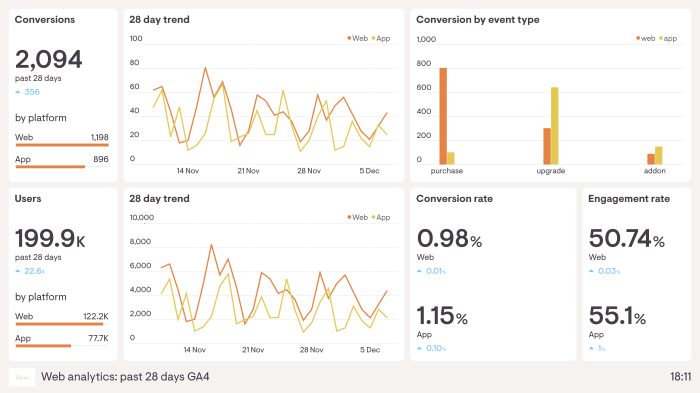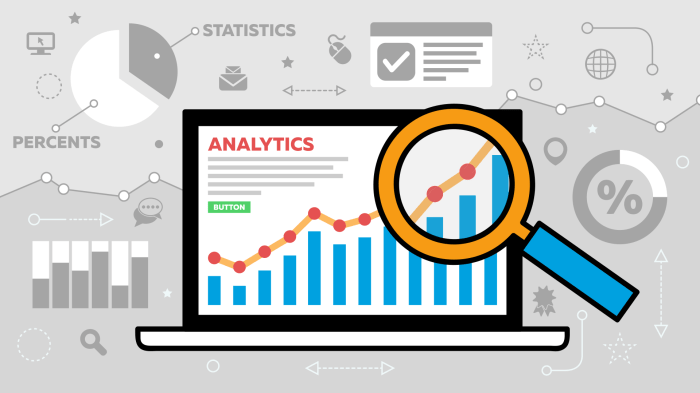Kicking off with Analyzing Website Analytics, this topic delves into the world of digital data, shedding light on the importance of website analytics for online businesses and the tools used to decipher user behavior.
From setting up Google Analytics to interpreting bounce rates and conversion metrics, get ready to navigate the realm of website analytics like a pro.
Importance of Website Analytics
In today’s digital age, website analytics play a crucial role in the success of online businesses. By analyzing and interpreting data related to website traffic and user behavior, businesses can make informed decisions to optimize their online presence and drive growth.
Understanding User Behavior
Website analytics provide valuable insights into how users interact with a website. By tracking metrics such as page views, bounce rates, and conversion rates, businesses can gain a deeper understanding of what content resonates with their audience and what areas need improvement.
- Page Views: This metric indicates the number of times a particular page on the website has been viewed. It helps businesses identify popular pages and optimize content accordingly.
- Bounce Rate: The bounce rate measures the percentage of visitors who navigate away from the site after viewing only one page. A high bounce rate may signal that the website content is not engaging enough or that there are usability issues that need to be addressed.
- Conversion Rate: This metric tracks the percentage of visitors who complete a desired action on the website, such as making a purchase or signing up for a newsletter. Monitoring the conversion rate helps businesses assess the effectiveness of their marketing campaigns and website design.
Types of Website Analytics Tools: Analyzing Website Analytics

When it comes to tracking and analyzing data on your website, there are various tools available in the market. These tools help you understand your audience, their behavior, and how they interact with your site. Let’s compare and contrast different website analytics tools and delve into the world of free versus paid options.
Google Analytics
Google Analytics is one of the most popular website analytics platforms out there. It offers a wide range of features to help you track and analyze your website’s performance. Some key features of Google Analytics include:
– Real-time data tracking to see what’s happening on your site at any given moment.
– Audience demographics and behavior insights to understand who your visitors are and how they engage with your content.
– Conversion tracking to measure the effectiveness of your marketing campaigns and website goals.
– Customizable reports and dashboards to tailor the data to your specific needs.
– Integration with other Google products like Google Ads for a comprehensive view of your online presence.
Free vs. Paid Tools
When it comes to choosing between free and paid website analytics tools, the main difference lies in the level of features and support you receive. Free tools like Google Analytics offer robust capabilities at no cost, making them ideal for small businesses or individuals on a budget. On the other hand, paid tools like Adobe Analytics or SEMrush provide more advanced features, dedicated support, and additional services for a subscription fee. The choice between free and paid tools ultimately depends on your specific needs and budget.
Other Website Analytics Tools
Apart from Google Analytics, there are other popular website analytics tools in the market, each with its own unique features and benefits. Some of these include:
– Adobe Analytics: Offers advanced analytics and reporting capabilities for enterprise-level businesses.
– SEMrush: Provides comprehensive tools along with website analytics to improve online visibility.
– Hotjar: Focuses on user behavior with heatmaps, session recordings, and feedback polls.
– Crazy Egg: Offers heatmaps, scroll maps, and A/B testing for optimizing website performance.
Overall, the key is to choose a website analytics tool that aligns with your goals, budget, and level of expertise to make the most out of tracking and analyzing your website data.
Setting Up Website Analytics
Setting up website analytics is crucial for tracking and analyzing the performance of your website. One popular tool for this purpose is Google Analytics, which provides valuable insights into visitor behavior, traffic sources, and more. Here are the steps involved in setting up Google Analytics on a website:
Setting Up Google Analytics, Analyzing Website Analytics
To set up Google Analytics on your website, follow these steps:
- Create a Google Analytics account by visiting the Google Analytics website and signing up for an account.
- Set up a new property in your Google Analytics account for your website by entering your website name, URL, and time zone.
- Get your tracking ID from Google Analytics and add it to your website’s HTML code before the closing tag.
- Verify that the tracking code is working by checking the Real-Time reports in Google Analytics and visiting your website to see if data is being collected.
- Configure goals and filters in Google Analytics to track specific actions on your website, such as form submissions or purchases.
Integrating Analytics Tools with Your Website
Integrating analytics tools with your website involves adding tracking codes provided by the analytics tool to your website’s HTML code. This allows the analytics tool to collect data on visitor behavior, traffic sources, and other important metrics. Different analytics tools may have specific instructions for integration, so it’s important to follow the guidelines provided by the tool.
Best Practices for Configuring Website Analytics
Configuring website analytics properly is essential for gathering accurate data. Some best practices include:
- Set up goals in Google Analytics to track specific actions that are important to your business objectives.
- Use UTM parameters in your URLs to track the effectiveness of marketing campaigns and traffic sources.
- Regularly review and analyze your website analytics data to identify trends, opportunities for improvement, and areas that need attention.
- Ensure that your analytics tracking code is properly implemented on all pages of your website to capture data accurately.
- Consider setting up custom reports and dashboards in Google Analytics to visualize data in a way that is meaningful and actionable.
Interpreting Website Analytics Data

Understanding and interpreting website analytics data is crucial for making informed decisions to improve the performance of your online presence.
Significance of Bounce Rate
The bounce rate indicates the percentage of visitors who navigate away from your site after viewing only one page. A high bounce rate may suggest that visitors are not finding what they are looking for or that the landing page does not meet their expectations. It is essential to analyze the bounce rate to identify potential issues and make necessary improvements to enhance user experience and engagement.
Interpreting Conversion Rates
Conversion rates measure the percentage of visitors who complete a desired action on your website, such as making a purchase or filling out a form. Understanding conversion rates is essential for evaluating the effectiveness of your online marketing efforts and assessing how well your website is meeting its business goals. By analyzing conversion rates, you can identify areas for improvement and optimize your website to drive more conversions.
Actionable Insights from Website Analytics
– Identifying popular content: Analyzing which pages receive the most traffic can help you understand what resonates with your audience and tailor your content strategy accordingly.
– Understanding user behavior: Tracking user interactions, such as time spent on a page or click-through rates, can provide valuable insights into how visitors engage with your site.
– Improving performance: Monitoring performance and organic traffic can help you optimize your website for better search engine rankings and attract more organic visitors.





